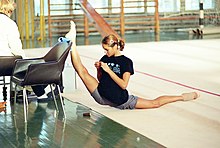Flexibility (anatomy)


Flexibility refers to the absolute range of movement in a joint or series of joints, and length in muscles that cross the joints. Flexibility is variable between individuals, particularly in terms of differences in muscle length of multi-joint muscles. Flexibility in some joints can be increased to a certain degree by exercise, with stretching a common exercise component to maintain or improve flexibility.
Quality of life is enhanced by improving and maintaining a good range of motion in the joints. Overall flexibility should be developed with specific joint range of motion needs in mind as the individual joints vary from one to another. Loss of flexibility can be a predisposing factor for physical issues such as pain syndromes or balance disorders.
Gender, age, and genetics are important for your range of motion. Exercise including stretching often helps you be more flexible.
Many factors are taken into account when establishing personal flexibility: joint structure, ligaments, tendons, muscles, skin, tissue injury, fat (or adipose) tissue, body temperature, age and gender all influence an individual's range of motion about a joint.
Individual body flexibility level is measured and calculated by performing a sit and reach test, where the result is defined in personal flexibility score.
See also
References
Appleton, Brad. Stretching and Flexibility. www.cmcrossroads.com. URL accessed on February 10, 2005.
